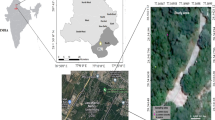Summary
Water use patterns and the seasonal progression of functional leaf area were determined for Solidago canadensis L. var. scabra and S. juncea Ait., two species of cooccurring goldenrods which differ in their competitive ability and distribution along soil moisture gradients. Field measurements of diurnal trends in stomatal conductances and leaf water potentials indicate little difference between the species. Laboratory gas exchange measurements of assimilation rates (13.15–13.25 micromoles CO2 m-2 sec-1), stomatal conductances (31.53–38.44 centimoles H2O m-2 sec-1), water use efficiencies (8.10–9.66 mg CO2 g H2O-1) and stomatal response to low leaf water potentials (i.e. initiation of stomatal closure at -16 to -20 bars) were also similar for the two species. Differences in their maximum functional leaf areas (421 cm2 vs 209 cm2 for S. canadensis and S. juncea, respectively, at maturity), phenologies (S. juncea flowers about one month earlier than S. canadensis) and the presence of the non-reproductive rosette habit in the dry site species (S. juncea) are probably more important in explaining the differential distributions of these two species than differences in their water use patterns.
Similar content being viewed by others
References
Bazzaz FA (1979) Physiological ecology of plant succession. Ann Rev Ecol Syst 10:351–371
Farquhar GD, Raschke K (1978) On the resistance to transpiration of the sites of evaporation within the leaf. Plant Physiol 61:1000–1005
Kanemasu ET, Thurtell GW, Tanner CB (1969) Design calibration and field use of a stomatal diffusion porometer. Plant Physiol 44:881–885
Larcher W (1975) Physiological plant ecology. Springer Verlag, New York, p 252
Mantuani MA (1970) Adaptation to drought, a comparison of two closely related species of Solidago from the Sierra Nevada of California. PhD Thesis, Duke University
Scholander PF, Hammell HT, Bradstreet ED, Hemmingsen ED (1965) Sap pressure in vascular plants. Science 148:339–346
Scoggan HJ (1979) The flora of Canada: Part 4, Dicotyledoneae, pp 1117–1711, National Museum of Natural Sciences Publications in Botany, no 7 (4), National Museums of Canada, Ottawa
Turner NC, Jones MM (1980) Turgor maintenance by osmotic adjustment: A review and evaluation. In: Adaptation of plants to water and high temperature stress. John Wiley and Sons, Inc
Werner PA, Bradbury IK, Gross RS (1980) The biology of Canadian weeds. 45. Solidago canadensis L. Can J Plant Sci 60:1393–1409
Werner PA, Platt WJ (1976) Ecological relationships of co-occuring goldenrods (Solidago: Compositae). Amer Natur 110:959–971
Author information
Authors and Affiliations
Rights and permissions
About this article
Cite this article
Potvin, M.A., Werner, P.A. Water use physiologies of co-occurring goldenrods (Solidago juncea and S. canadensis): Implications for natural distributions. Oecologia 56, 148–152 (1983). https://doi.org/10.1007/BF00379684
Received:
Issue Date:
DOI: https://doi.org/10.1007/BF00379684




